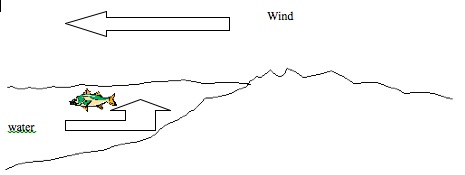El Nino in a Bowl
Summary
Students model formation of an El Nino current in a pie pan.
Materials
Attachments
- clear glass pie plate
- cold salty water with some red food coloring in it
- warm fresh water
- paper circles
- turkey baster or large pipet (optional)
- plastic beakers
- student page (attached)
Student Prior Knowledge
Students should know that El Nino is the name given to a certain combination of weather events that occur in a cyclic pattern. The interaction between prevailing winds and ocean water creates the effect. Students need to be aware that the coldest ocean water is most dense and stays at the bottom of the sea. It contains the most nutrients for living things. Living things need light and must live at the oceans surface. Typically, the prevailing winds blow surface water away from the coast and draw up colder nutrient rich water from the bottom. Schools of fish are attracted to the plankton that quickly grows there. During an El Nino year, the winds die or blow erratically and the water is not drawn up. Fish populations go down and weather patterns change as the pool of warmer water sits by the coast.
Instructional Procedures
- Read the procedures with students. If turkey basters are not being used, the student can pour the cold water from a beaker into the pie plate.
- Students should see the red water collect right where their breath is blowing strongly. If students have difficulty seeing this it can be demonstrated on an overhead projector as long as you don't turn on the light until you are ready. The light will heat up the water and it will mix.
- Students should be encouraged to try the test several times and build a new ocean if they don't succeed at first.
- Discuss the results with students and give them time to answer the questions.
Assessment Plan
Attachments
Scoring Guide:
1. Students set up and perform experiment………………..4
2. Students collect and record data………………………….4
3. Students correctly answer analysis questions…………4
Answers:
- it is densest
- the wind moves the surface water away, pulling up the bottom water
- the surface water continues to warm up
- the cold water contains nutrients
- air over warm water heats up and gathers moisture
- when it hits land it may cool and precipitate
-

Bibliography
Lesson Design by Jordan School District Teachers and Staff
Updated: 02/04/2018


 UTAH EDUCATION NETWORK
UTAH EDUCATION NETWORK

 Justin
Justin Braxton
Braxton Dani
Dani Kayla
Kayla Katie
Katie Matthew
Matthew Rob
Rob Val
Val
